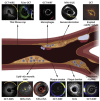Emerging Image-Guided Navigation Techniques for Cardiovascular Interventions: A Scoping Review
- PMID: 40428106
- PMCID: PMC12108902
- DOI: 10.3390/bioengineering12050488
Emerging Image-Guided Navigation Techniques for Cardiovascular Interventions: A Scoping Review
Abstract
Background: Image-guided navigation has revolutionized precision cardiac interventions, yet current technologies face critical limitations in real-time guidance and procedural accuracy. Method: Here, we comprehensively evaluate state-of-the-art imaging modalities, from conventional fluoroscopy to emerging hybrid systems, analyzing their applications across coronary, structural, and electrophysiological interventions. Results: We demonstrate that novel approaches combining optical coherence tomography with near-infrared spectroscopy or fluorescence achieve unprecedented plaque characterization and procedural guidance through simultaneous structural and molecular imaging. Our analysis reveals key challenges, including imaging artifacts and resolution constraints, while highlighting recent technological solutions incorporating artificial intelligence and robotics. We show that non-imaging alternatives, such as fiber optic real-shape sensing and electromagnetic tracking, complement traditional techniques by providing real-time navigation without radiation exposure. This paper also discusses the integration of image-guided navigation techniques into augmented reality systems and patient-specific modeling, highlighting initial clinical studies that demonstrate their significant promise in reducing procedural times and improving accuracy. These findings establish a framework for next-generation cardiac interventions, emphasizing the critical role of multimodal imaging platforms enhanced by AI-driven decision support. Conclusions: We conclude that continued innovation in hybrid imaging systems, coupled with advances in automation, will be essential for optimizing procedural outcomes and expanding access to complex cardiac interventions.
Keywords: artificial intelligence; cardiac imaging; image-guided navigation; interventional cardiology; multimodal imaging.
Conflict of interest statement
The authors declare no conflicts of interest.
Figures




Similar articles
-
Tracking and Navigation Technologies for Image-Guided Trans-Arterial Interventions.Tech Vasc Interv Radiol. 2024 Dec;27(4):101010. doi: 10.1016/j.tvir.2024.101010. Epub 2024 Nov 22. Tech Vasc Interv Radiol. 2024. PMID: 39828388 Review.
-
Artificial Intelligence in Thoracic Surgery: A Review Bridging Innovation and Clinical Practice for the Next Generation of Surgical Care.J Clin Med. 2025 Apr 16;14(8):2729. doi: 10.3390/jcm14082729. J Clin Med. 2025. PMID: 40283559 Free PMC article. Review.
-
The Role of Artificial Intelligence in Providing Real-Time Guidance During Interventional Cardiology Procedures: A Narrative Review.Cureus. 2025 May 4;17(5):e83464. doi: 10.7759/cureus.83464. eCollection 2025 May. Cureus. 2025. PMID: 40322608 Free PMC article. Review.
-
[Status Quo of Surgical Navigation].Zentralbl Chir. 2024 Dec;149(6):522-528. doi: 10.1055/a-2211-4898. Epub 2023 Dec 6. Zentralbl Chir. 2024. PMID: 38056501 Review. German.
-
Fusion Technologies for Image-Guided Robotic Interventions.Tech Vasc Interv Radiol. 2024 Dec;27(4):101009. doi: 10.1016/j.tvir.2024.101009. Epub 2024 Nov 26. Tech Vasc Interv Radiol. 2024. PMID: 39828383 Review.
References
-
- Ullah A., Kumar M., Sayyar M., Sapna F., John C., Memon S., Qureshi K., Agbo E.C., Ariri H.I., Chukwu E.J., et al. Revolutionizing cardiac care: A comprehensive narrative review of cardiac rehabilitation and the evolution of cardiovascular medicine. Cureus. 2023;15:e46469. doi: 10.7759/cureus.46469. - DOI - PMC - PubMed
-
- Rogers T., Campbell-Washburn A.E., Ramasawmy R., Yildirim D.K., Bruce C.G., Grant L.P., Stine A.M., Kolandaivelu A., Herzka D.A., Ratnayaka K., et al. Interventional cardiovascular magnetic resonance: State-of-the-art. J. Cardiovasc. Magn. Reson. 2023;25:48. doi: 10.1186/s12968-023-00956-7. - DOI - PMC - PubMed
-
- Sachdeva R., Armstrong A.K., Arnaout R., Grosse-Wortmann L., Han B.K., Mertens L., Moore R.A., Olivieri L.J., Parthiban A., Powell A.J. Novel techniques in imaging congenital heart disease: JACC scientific statement. J. Am. Coll. Cardiol. 2024;83:63–81. doi: 10.1016/j.jacc.2023.10.025. - DOI - PMC - PubMed
Publication types
Grants and funding
LinkOut - more resources
Full Text Sources

